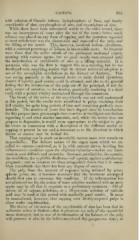Page 885 - My FlipBook
P. 885
CAPPING. 895
with solution of Canada balsam, lactophosphate of lime, and finally
oxychloride of zinc, oxyphosphate of zinc, and oxysulphate of zinc.
While these have been introduced nearly in the order named, there
was an interregnum of years after the use of the metals before much
reliance was placed on any form of capping, and the operation regarded
as most satisfactory was the destruction and removal of the pulp and
the filling of the canals. This, however, involved tedious operations,
with a constant percentage of failures in inaccessible roots. So frequent
were these that the active minds of the profession continued experi-
menting with various agents, but no good results were attained until
the introduction of oxychloride of zinc as a filling material. It is
uncertain who was the first to suggest this as a covering, but its use
developed such surprising results that its almost universal adoption is
one of the remarkable revolutions in the history of dentistry. This
was owing partially to the general desire to make dental operations
shorter if equally good results could be attained, and also to the general
feeling that the destruction of the pulp cut off the principal, if not the
only, source of nutrition to the dentine, practically rendering it a dead
tooth with a partial vitality maintained through the cementum.
The theory of the action of the oxychloride was not well understood
at this period, but the results were manifested in pulps retaining their
full vitality for (juite long periods of time and remaining perfectly com-
fortable. The number of years that have elapsed since its introduction
for this purpose have given ample time to arrive at intelligent conclusions
regarding it and other similar materials, and, while the writer does not
propose to dogmatize, it w^ould seem appropriate to the subject to give
his views in connection with a description of the different modes of
capping at present in use and a statement as to the direction in which
failure or success may be looked for.
That capping can be made an invariable success must ever remain an
impossibility. The delicate nature of t4ie organ upon M'hich we are
called to operate—endowed, as it is, with sensory nerves inviting the
inflammatory condition upon the slightest irritation—makes any treat-
ment at once difficult and uncertain. Systemic peculiarities, the anaemic,
the scrofulous, the syphilitic diatheses,—all operate against a satisfactory
prognosis ; and so common are these antagonistic forces that it is some-
what remarkable that there has been any degree of success.
The pulp from the moment of exposure being irritated by atmo-
spheric germs, etc., it becomes necessary that the treatment attempted
should first aim to overcome this condition. If the inflammation has
not advanced too far, the action of some sedative combined with an anti-
septic may be all that is requisite as a preliminary treatment. Oil of
cloves, oil of cajeput, iodoform, or a 10-per-cent. solution of carbolic
acid may be used at this period with markedly good results. It must
be remembered, however, that capping over freshly-exposed pulps is
alone under consideration.
The theory of the action of the oxychloride of zinc has been that its
escharotic action is limited—that it preserves not only all the superficial
tissue destroyed, but in case of devitalization of the balance of the pulp
will preserve it also in the before-mentioned dry-gangrenous state ; so


